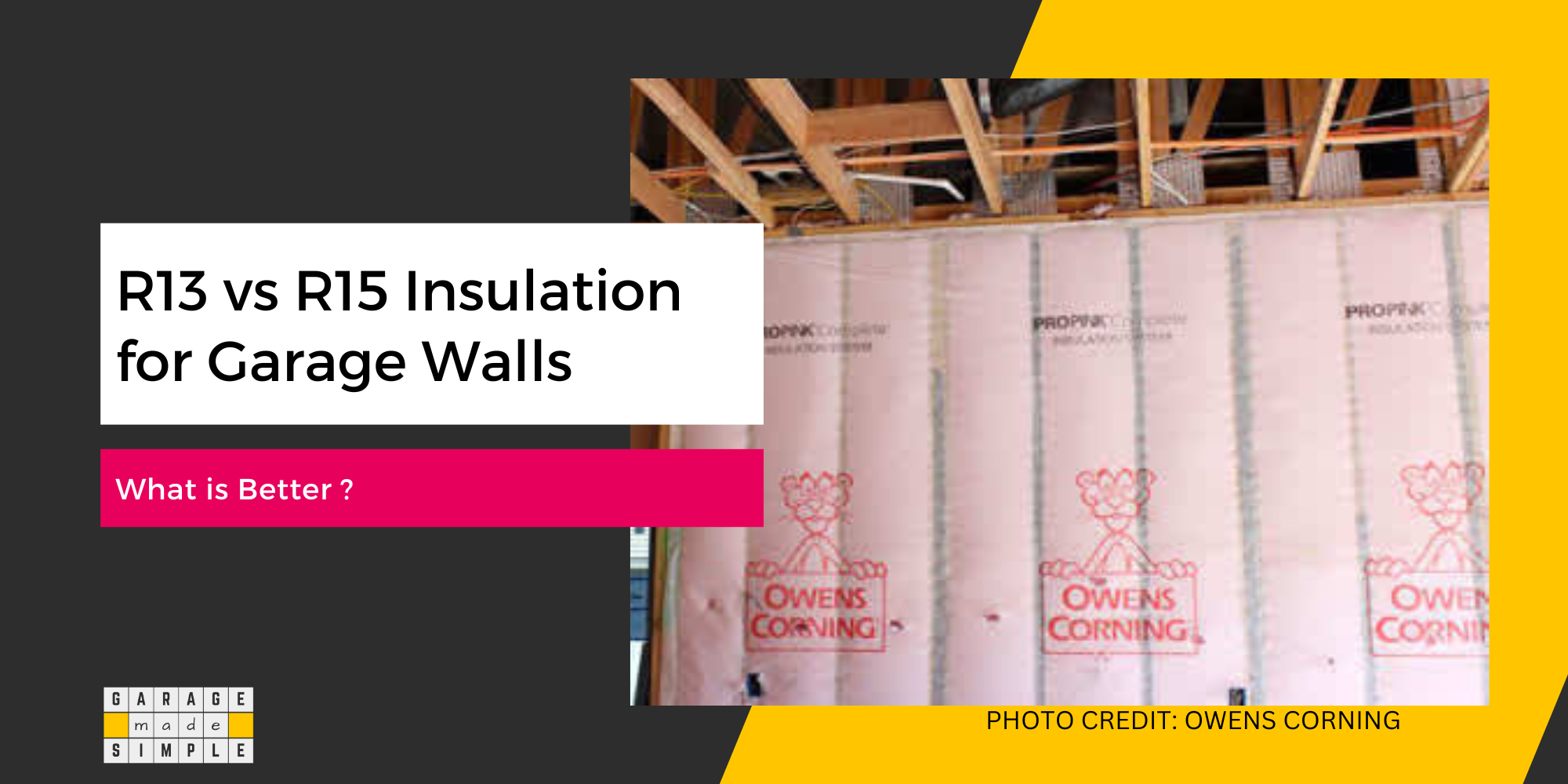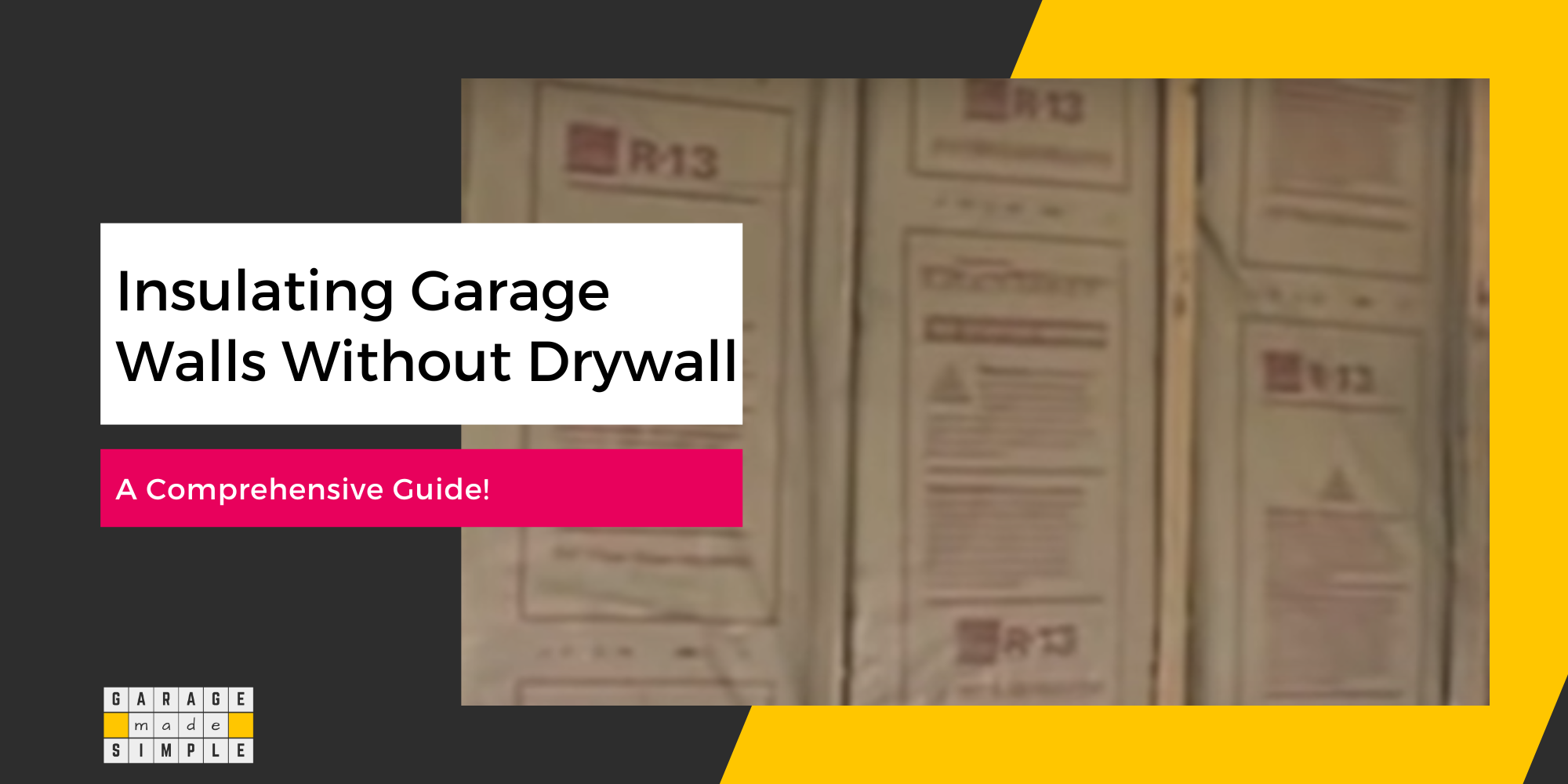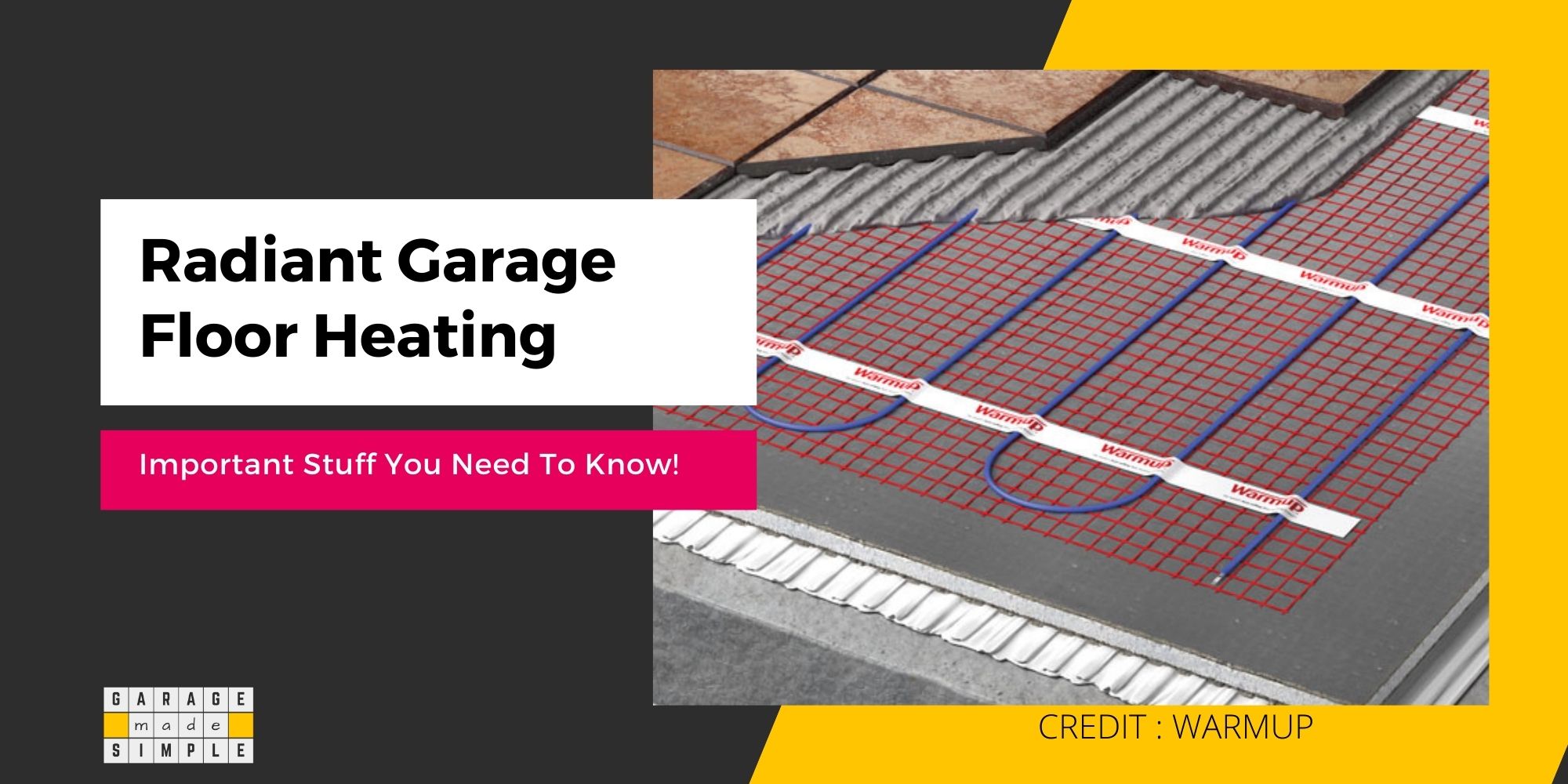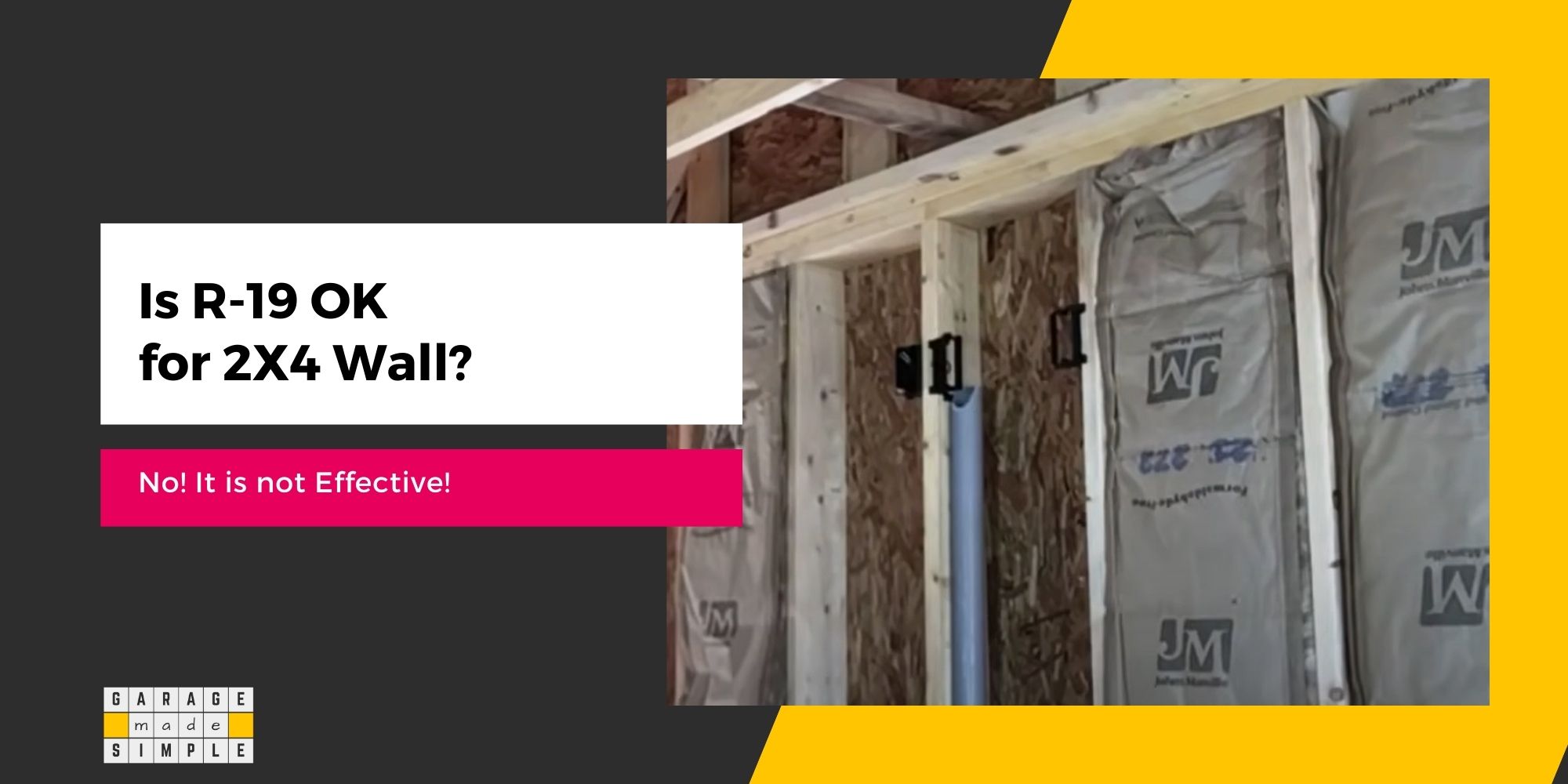Garage Door Panel Insulation: Comprehensive Guide 2024!
As an Amazon Associate, I earn from qualifying purchases.
A stylish garage door boosts the curb appeal of your home. However, non-existing or inadequate garage door panel insulation can also inflate your energy costs, due to heat loss during cooler periods.

Garage door panel insulation is crucial to maintaining a comfortable and energy-efficient home. Garage door insulation helps regulate the temperature within your garage and protects parked cars and other stored items from extreme temperatures.
As a bonus, garage door panel insulation also minimizes noise from outside, enhancing the overall comfort of your living space.
This comprehensive guide will explore the benefits of garage door panel insulation, discuss the various types, and provide a buyer’s guide.
Benefits of Garage Door Panel Insulation
There are many benefits of garage insulation, some important ones are listed below.
Temperature Control
The garage door is typically made of some metal, such as steel, aluminum, etc. During winter, you will lose a lot of your home heat, through your garage door as metals and even PVC, are excellent conductors of heat.
During winter, garage door panel insulation prevents rapid heat loss and results in better temperature control. It keeps the garage warmer.
Conversely, in summer, it helps maintain a cooler interior by blocking external heat from entering the garage through the metal or PVC doors.
In essence, garage door panel insulation ensures a stable temperature and a more comfortable environment.
Energy Efficiency
You can reduce energy costs significantly by using garage door panel insulation. Insulation is a barrier between the extreme outdoor temperature and the desired temperature within the garage.
As a result, your heating and cooling systems don’t have to work as hard to maintain a stable indoor climate, leading to energy savings.
Noise Reduction
Garage doors can be noisy, especially if they’re thin and lack insulation. Garage door panel insulation dampens sound transmission, creating a quieter space.
Whether it’s the rumble of street traffic or the neighbor’s lawnmower, proper garage door insulation will minimize unwanted noise pollution from outside.
With an insulated garage door, you can concentrate better on your DIY projects or put your garage to more peaceful uses, such as reading, meditation, or watching your favorite game on TV.
Protection of Stored Items
Extreme temperatures can harm items stored in your garage. The longevity of cars, and their parts, is adversely affected by extreme cold or extreme heat.
Many items that you store in your garage are sensitive to extreme temperatures. Many items will say “Store in a cool, dry place”. Whether it’s tools, sports equipment, or seasonal decorations, they all tend to deteriorate faster when it is too hot or too cold.
Garage door panel insulation ensures the temperature remains, within moderate levels, shielding cars and other stored items from extreme cold or heat.
Increased Property Value
Potential buyers appreciate the energy-efficient features of a home, and an insulated garage door is an attractive selling point. Investing in garage door panel insulation enhances the overall value of your home.
Types of Garage Door Panel Insulation
When selecting the garage door panel insulation, you must understand the options available and how they meet your specific needs.
Below are the most common garage door panel insulation materials, each with its benefits, R-value, and cost.
1. Polystyrene Foam (Styrofoam)
- Overview:
- Polystyrene foam, (aka Styrofoam), is a lightweight and cost-effective option widely used in garage door panel insulation.
- Benefits:
- Polystyrene foam provides moderate thermal resistance, making it suitable for regions with mild climates where temperature extremes are not a significant concern.
- R-Value & Cost:
- Typically, this type of insulation has an R-value between R-4 and R-6. For example, the Matador Garage Door Insulation, recommended below, has an R-value of 4.8 at 75 degree Fahrenheit, according to the manufacturer.
- It’s an economical choice, commonly found in standard 2” thick steel back garage doors.
Recommended Product
Matador 1-Car Garage Door Insulation
- Installation in 3 easy steps
- Installation does not require tapes, glues, or pins
- Fits most standard pan-style 8-foot and 9-foot garage doors
- Panels scored for easy installation; No special tools are required
- Includes 8 high-impact polystyrene laminate panels 20. 25″ H x 54″ W x 1. 25″ thick
2. Fiberglass Insulation
- Overview:
- Fiberglass panels are another option to consider. They are known for their excellent thermal resistance and sound-dampening properties. They are a great choice for garage wall insulation.
- Benefits:
- Fiberglass panels are easy to work with and fit well into garage door panels. They are gaining in popularity as garage door panel insulation and reducing noise.
- R-Value & Cost:
- Fiberglass insulation typically has an R-value that is somewhat higher than polystyrene foam, around R-8. An example is the recommended product listed below.
- It is widely used as garage door panel insulation and is a cost-effective solution.
Recommended Product
Owens Corning Garage Door Insulation Kit
- 5 times better thermal performance, compared to an uninsulated door
- As much as 20% reduction in perceived noise level
- Installs in less than 1 hour (up to 9′ door) – Only tools needed for installation are tape measure, utility knife, straight-edge, and marker
- Flexible material resists denting
- Cleanable vinyl surface (w/mild detergent)
3. Reflective Barriers
- Overview:
- Reflective barriers consist of multiple layers of foil designed to reflect radiant heat away from the garage, making them particularly effective in hot climates.
- Benefits:
- Reflective barriers are lightweight, easy to install, and minimize heat gain during warmer months.
- R-Value & Cost:
- Reflective barriers reflect heat rather than insulate. As such the reflectivity rather than the R-value is relevant.
- They are a budget-friendly option but not the right choice for cold climates.
Recommended Product
US ENERGY PRODUCTS NASATEK Reflective 1 Car Garage Door Insulation
- All-In-One Kit Contains everything you need to insulate your Garage Door
- Improves Thermal Performance
- Easily Installs in 60 Minutes or Less
- Increased R-Value and E-Value
- 4 Rolls of 9ft x 24 inch
- Double Sided GDK Tape
4. Polyurethane Foam
- Overview:
- Polyurethane foam is a high-density insulation material known for its superior performance in energy efficiency.
- Benefits:
- Polyurethane foam excels in thermal insulation, with a higher R-value than polystyrene, which means a higher resistance to heat transfer, better insulation, and a higher R-value.
- R-Value & Cost:
- With an impressive R-value ranging from R-13 to R-19, polyurethane foam is better suited for regions with long, harsh winters. It provides substantial energy savings.
- Though it comes at a higher cost, its effectiveness in reducing heat transfer justifies the investment.
Recommended Product
Garage door panel insulation kits using polyurethane foam are typically not available online or off the shelf. However, you can order them from well-known garage door manufacturers such as Amarr.
With triple-layer construction and superior insulation R-value of 13.35 or 19.40, the Amarr Olympus collection are durable, low-maintenance doors that give you the ultimate in quiet operation and energy efficiency.
Buyer’s Guide to Garage Door Panel Insulation
Choosing the Right Insulation
When deciding on the best insulation type for your garage door, consider your climate, budget, and energy-saving objectives. Each insulation material has advantages, so evaluate your needs to make the best choice for your home.
Understanding R-Value
The R-value is a measure of the material’s thermal resistance—how well it prevents heat transfer. For example, intrinsically, wood has a higher R-value than steel, for the same thickness.
Insulating materials, such as fiberglass batts or polystyrene boards have an even higher R-value for the same thickness. When it’s sweltering outside, insulation keeps the heat at bay, and it retains warmth indoors during chilly nights.
The way R-value is measured, can give you a misleading notion regarding its impact on reduction in heat flow. This is amply illustrated by the chart below.
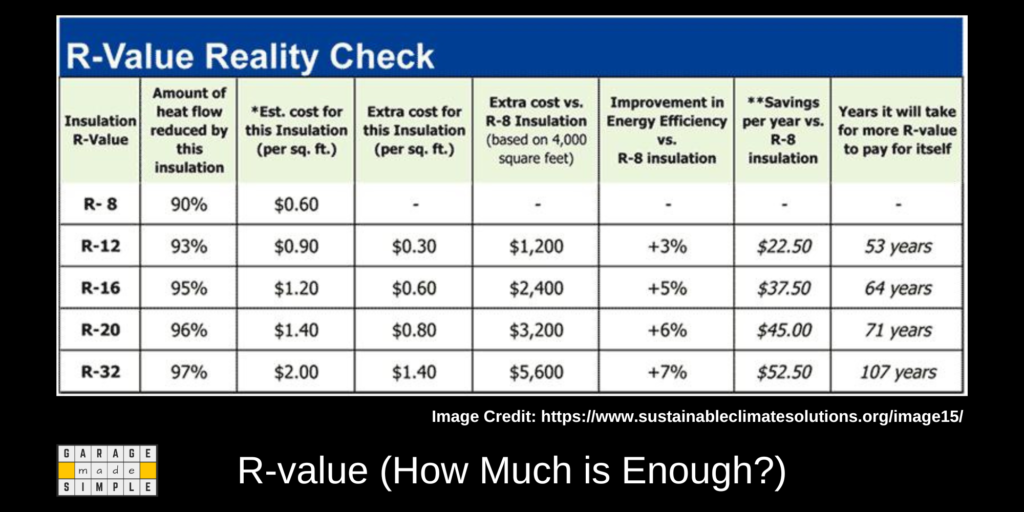
As you can see, R-16 is only 5% better than R-8 in energy efficiency but may cost you an extra $0.60 per sq ft.
What is a Good R-value for a Garage Door?
The answer to this question depends on:
- The manner in which the garage will be used.
- The climatic condition in your region
For an attached garage, aim for an R-value of around R-12 to R-16. For a detached garage with a workshop or other activities, an R-value of around R-6 to R-8 should be good enough.
Of course, you will need a higher R-value if you live in a zone with long, harsh winters.
Comparing Pre-Insulated vs Uninsulated Garage Doors
Most reputed garage door manufacturers sell their doors as pre-insulated and uninsulated. Below are 3 different options from Amarr, a leading garage manufacturer.
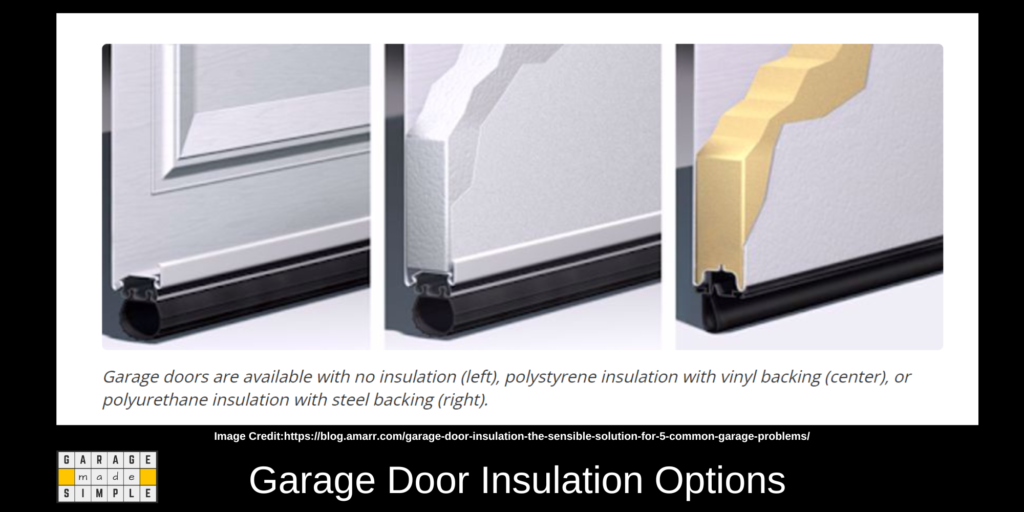
You have the option of buying a pre-insulated garage door or buying an uninsulated one and adding garage door panel insulation yourself. So, which option is better?
Pre-insulated Garage Doors: Pros & Cons
- Pros:
- Energy Efficiency: New insulated garage doors come with built-in insulation, providing excellent thermal resistance (R-values range from R-6 to R-19). Pick the one that is best for you.
- Convenience: No additional insulation installation steps are required; simply replace your existing door with an insulated one.
- Aesthetics: Upgrading to an insulated door enhances curb appeal and adds value to your home.
- Cons:
- Cost: Insulated garage doors are more expensive upfront compared to non-insulated doors.
- Limited Customization: Options for design and style may be narrower in the insulated category.
Uninsulated Garage Doors (with Insulation Added Later): Pros & Cons
- Pros:
- Cost Savings: Uninsulated garage doors are a lot cheaper than insulated garage doors. The cost of adding garage door panel insulation is usually less than $200.
- DIY Option: Garage door panel insulation typically comes as a kit and is super DIY friendly. You will save a lot on labor costs.
- Flexibility: You can choose the level of insulation (R-Values between R-2 and R-8), as well as the type of insulation, based on your needs.
- Cons:
- Aesthetics: The appearance of your existing door won’t change significantly.
- Potential Gaps: You need to ensure that you do not leave any gaps that compromise insulation effectiveness.
Thank you very much for reading the post. I do hope you found it informative and useful.




